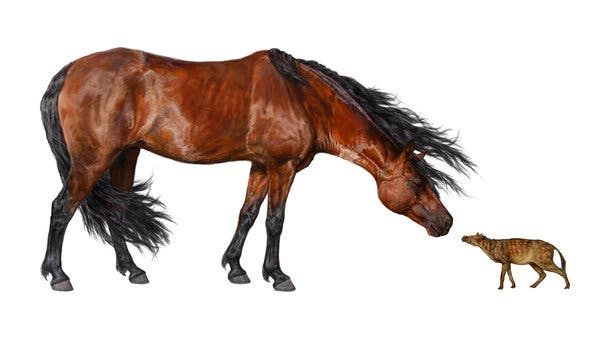Bergmann’s rule states that mammals of a given genus or species are smaller in hotter climates, and bigger in colder climates. Adapted, when faced with climate change cycles, mammals shirk as temperature rises and scale back up in size, once the cycle ends and makes room for cooling. Simple correlation, based on fossils and temperature readings from their given periods, seems to offer evidence supporting this principle – mammals shrink as the Earth warms. A latest study performed by scientists at Florida Museum of Natural History at the University of Florida, which looked at a brief, yet dramatic climate change,comes to the same conclusion.

Called the Paleocene-Eocene Thermal Maximum or PETM for short, this period in Earth’s history took place 56 million years ago and was marked by significant global warming, which lead to a temperature increase between 9 to 18 degrees Fahrenheit at the start, only to drop to almost initial values at the end – the age lasted for 175,000 years. It may seem like a long time, but in geological terms, well it’s nothing more than a blink of an eye – still a lot had happen.
“We had known it was a really unique event for a while in the sense that it was a very rapid, large scale global warming event. And it marks one of the most important moments in mammalian evolution in the sense that we see the first occurrence of several modern orders of mammals, including the primates that are clearly traceable as the direct ancestors of the group that we’re a part of, as well as the ancestors of horses, the ancestors of cows and hippos and camels,” said Jonathan Bloch, associate curator of vertebrate paleontology at the Florida Museum of Natural History at the University of Florida.
The tiniest horse to roam the Earth
One such mammal was Sifrhippus, one of the first horse species, which shrank from about 12 pounds average weight to about eight and a half pounds as the climate warmed over thousands of years. The first horses were a lot different from those of today; back then, they weren’t larger than a small dog or house cat. Interesting enough, the only Sifrhippus fossils found have been in Bighorn Basin of Wyomin, which today is the largest wild mustang reservation.
By studying various fossils like teeth or fragmentary jaws, the researchers were surprised to see the Sifrhippus become 30 percent smaller through the climate event , only to get 75 percent larger as it passed. They were able to tell this by studying the oxygen isotopes found in the horses’ teeth.
“What he showed was that exactly coincident with this body size change that we had documented there were shifts in the oxygen isotope that showed it was getting warmer as the horses were getting smaller. And then as the horses became larger again it became cooler,” Bloch said.
Indeed, the researcher’s findings conclude the change in size was, as suspected, driven primarily by the warming trend. A warmer climate seems to induce a shrinkage effect in mammals, which might be able to shed excess heat easier.
Mammals and climate change today?
Right now, the Earth is warming at a constant rate, however the temperature increase ins’t taking place through thousands of years, but hundreds – induced by humans, if not accelerated. Will today’s mammals get smaller in the future as well? Well, late last year I wrote a piece on how climate change has lead to a lose in size of 3-17% for most plants, while fish shrank by 6-22% – polar bears, among others, have been reportedly getting smaller as well. So, this is already happening. As for humans, we’ve been getting bigger and bigger, mostly because of better nutrition – the same goes for the ego, only its food is gluttony.
The team of researchers’ findings were reported in the journal Science.
Story and illustration via NYT.



